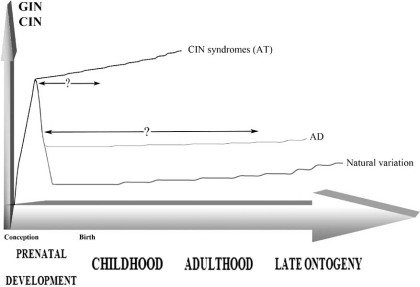Fig. (1).
Schematic representation of SGV manifested as GIN/CIN changing during ontogeny due to natural variations of the genome and in aging diseases: AT (CIN syndrome) and AD. Being increased in the early prenatal development, GIN/CIN decreases throughout following ontogeny stages, showing, however, a slight increase in the late ontogeny. In cases of CIN syndromes, GIN/CIN probably decreases insignificantly and demonstrates high rates after birth as exemplified by studying the AT brain [17, 32]. AD is suggested to be associated with failed clearance of cells affected by GIN/CIN exhibiting high rates of the chromosome 21 aneuploidy in diseased brain analyzed after the manifestation (late ontogeny) [7, 17, 21]. Intervals marked by question symbol show ontogenetic periods that have not been studied in context of SGV.

